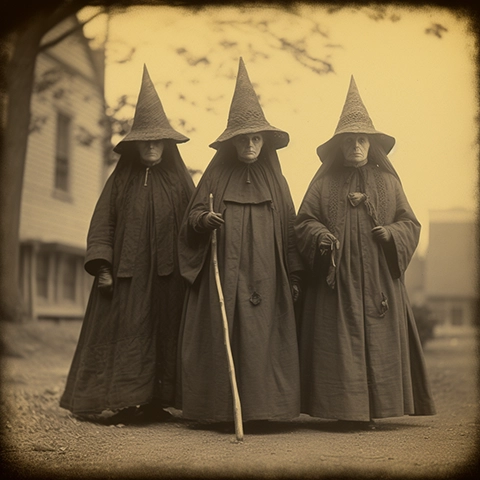In the crisp autumn of 1910, a peculiar event unfolded on the streets of Salem, Massachusetts, that would send shivers down the spines of locals and reverberate through the town’s history. Three sisters, their names now enshrined in the annals of Halloween lore, embarked on a frightful adventure that left the children of Salem trembling with fear and the community embroiled in a controversy that would be remembered for generations.
Salem, a town forever linked to the infamous witch trials of 1692, had long struggled to escape the shadows of its dark past. The mere mention of witches was enough to conjure images of hysteria, persecution, and malevolent enchantresses who had met their tragic fate in the trials. The wounds from that somber chapter of history were still fresh in the collective memory, and superstition hung in the air like an unshakable curse.
It was in this charged atmosphere that the three sisters, the Sablewood siblings, concocted a plan that was both audacious and audaciously controversial. The trio, known for their striking beauty and penchant for the unusual, decided to craft an extravagant Halloween spectacle. Their intention? To dress up as witches and terrify the local children in an unprecedented display of theatrical spookiness.
The sisters were well aware that such a display would stir the embers of Salem’s painful history. To enhance their mystique, they gathered an assortment of props from local folklore and legend, including cauldrons, broomsticks, and black cats. They donned tattered, medieval-style garments, complete with pointy hats and crooked noses. With their makeup and enchanting charisma, they bore an uncanny resemblance to the accused witches of centuries past.
As October 31st arrived, the Sablewood sisters took to the streets of Salem, their eerie laughter and cackles echoing through the narrow lanes. They strode through the town, leaving a trail of frightened children in their wake. Their performance was both captivating and terrifying, and the local residents were both astounded and appalled.
The controversy surrounding the sisters’ Halloween escapade was swift and unforgiving. Many citizens viewed their actions as insensitive and an affront to the memory of those who had suffered during the witch trials. The sisters’ audacity, intended to be a form of Halloween entertainment, had struck a nerve with the townsfolk, who still bore the weight of their history.
The story of the Sablewood sisters’ Halloween antics would eventually become part of Salem’s folklore, passed down from generation to generation. Their eerie performance and the ensuing controversy left an indelible mark on the town, further intertwining Salem with the mystique of witches.
Fast forward to 1993, and the Sablewood sisters’ escapades found a new lease on life. Their audacious Halloween performance served as the inspiration for the iconic cult classic film, “Hocus Pocus.” The movie, set in Salem, drew upon the controversial sisters and wove a tale of resurrection, witches, and the enduring legacy of the town’s history.
In the end, the Sablewood sisters’ Halloween scare might have been controversial at the time, but it ultimately became an integral part of Salem’s enduring legacy. Through their audacious display, they breathed life into the spirit of Halloween, and in doing so, they became a part of the rich tapestry of Salem’s history, ensuring that their legacy would live on for generations to come.

